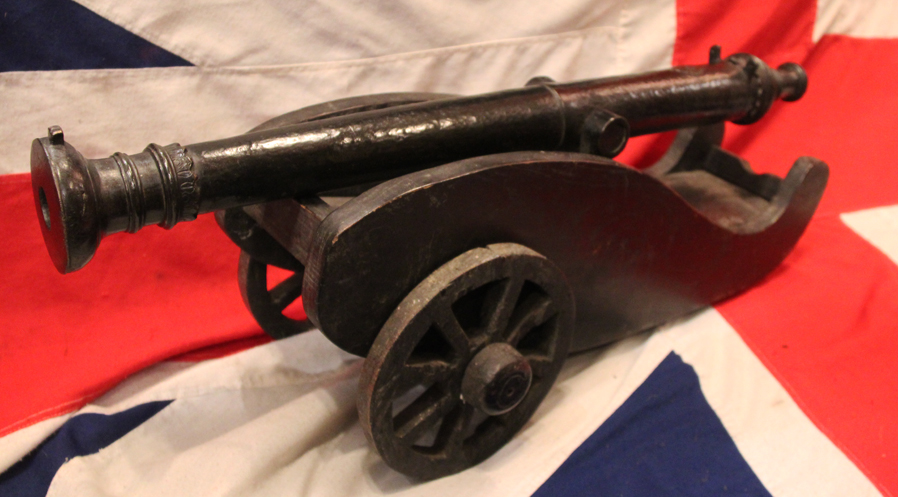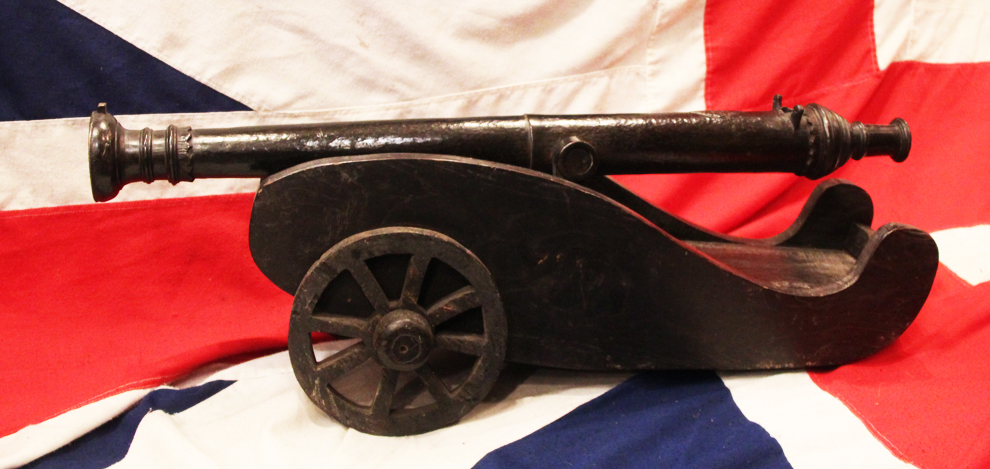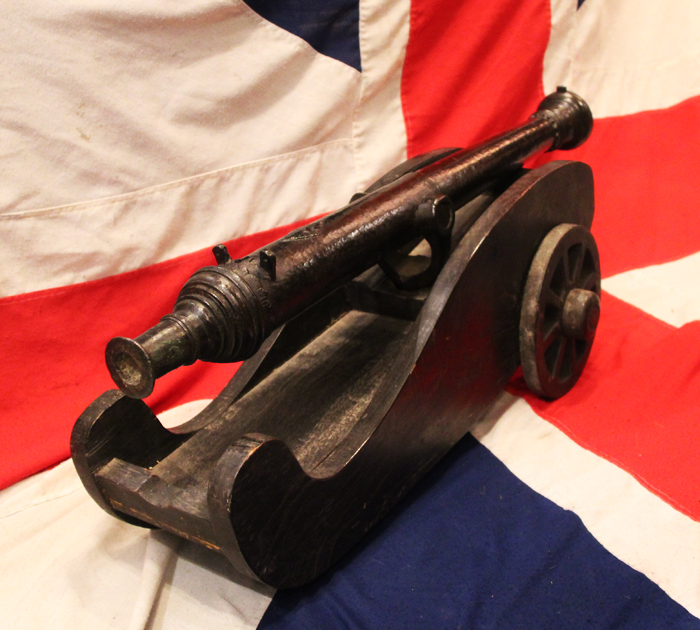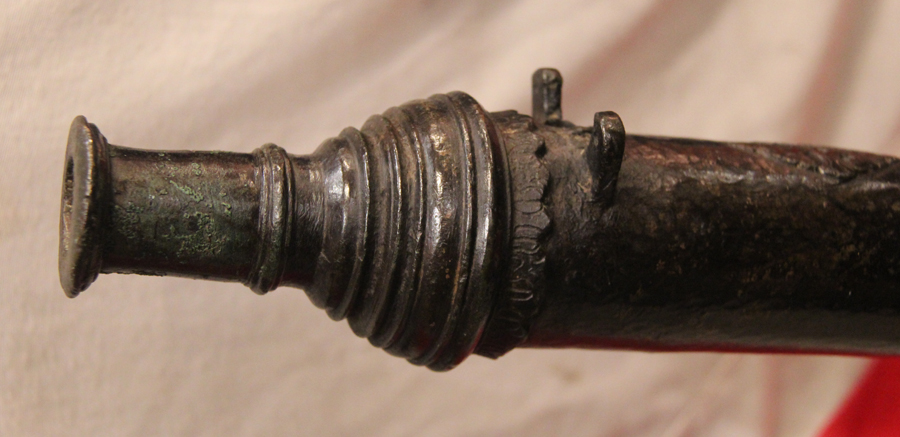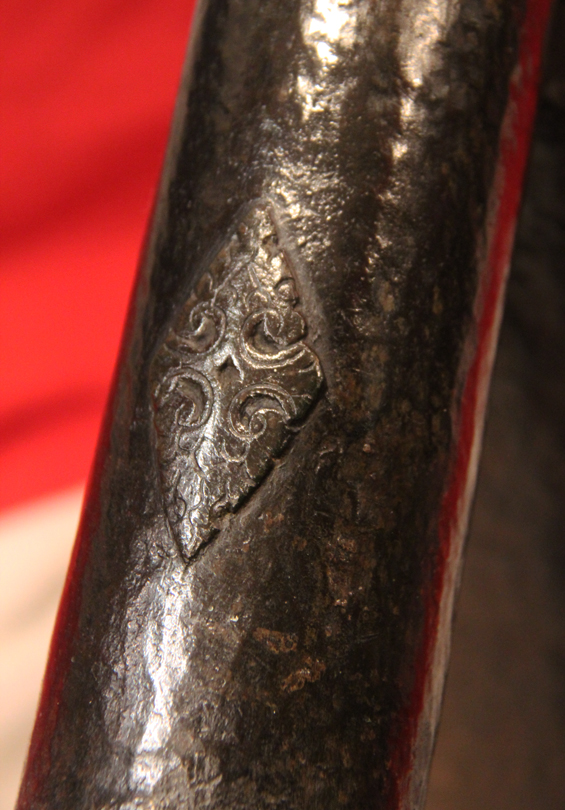A Superb 17th -18th Century Dutch East India Company Bronze Naval ‘Swivel’ Cannon on Carriage. A Cannon Of Stunning Quality And Exemplary Condition
A wonderful 17th to 18th century cast bronze swivel cannon, also called rail gun or a naval deck cannon, mounted on a beautiful antique carved hardwood carriage. The cannon can be hand lifted and easily removed in order to mount on other mounting blocks for swivels when used at sea. Solid bronze, with superb cast detailing, barrel measuring approximately 31.25 inches long, 31.75 inches long on carriage, with long ‘swivel spike’ on the underside of the barrel. The natural aged patination is absolutely fabulous and can only appear gradually over the passing of the centuries. This is truly a wonderful example worthy of any museum grade display. These cannon were made in the Netherlands and used by the VOC and by the legendary Malay pirates, and with suitable small cannon-balls it was a most powerful offensive weapon. Lantakas were manufactured during the 17th and early 18th century in the Netherlands by the Dutch East India Company for export to Indonesia, Malaysia and Philippines. This is a type of bronze swivel gun mounted on merchant vessels travelling the waterways of the Malay Archipelago. Its use was greatest in pre-colonial South East Asia especially in Malaysia, the Philippines, and Indonesia. The guns were used to defend against pirates demanding tribute for the local chief, or potentate. Cannon were frequently part of the bride price demanded by the family of an exceptionally desirable bride or the dowry paid to the groom.
Many of the small cannon, often called personal cannon or hand cannon, had been received as honours and were kept and passed down in families, but in times of need they also served as a form of currency that could keep the family fed. As a recognized form of currency, cannon could be traded for rice, drums, canoes, tools, weapons, livestock, debts of honour, and even settlement of penalties for crimes ranging from the accidental death of a fellow villager to headhunting against another tribe. Many of these finest cannon were given out by the Sultans of Brunei as part of ceremonies (such as birthdays or weddings) of the many princes and princesses of the extended Royal family. Cannon were frequently presented to guests along with awards and titles, and were meant to guarantee the recipients allegiance to the Sultan. In the 1840s, England began suppressing headhunting and piracy and Rajah James Brooke (a wealthy Englishman who established the dynasty that ruled Sarawak from 1841 until 1946) distributed numerous Brunei-cast hand cannon to guarantee the cooperation and allegiance of the local chiefs. Although most lantaka weighed under two hundred pounds, and many only a few pounds, the largest ones exceeded a thousand pounds with some weighing over a ton. Many of these guns were mounted on swivels and were known as swivel guns. The smaller ones could be mounted almost anywhere including in the rigging. Medium-sized cannon were frequently used in reinforced sockets on the vessel's rails and were sometimes referred to as rail guns. The heaviest swivel guns were mounted on modified gun carriages to make them more portable.
Typically the earliest cannon with beautiful ornaments from this region are from foundries in Malacca and Pahang, with later models from foundries in the Netherlands and Portugal, next from their respective settlements, and finally from Brunei and other local craftsmen.
The local population was unimpressed with the might and power of the heavily armed trading vessels from the VOC Dutch East India Company and Portugal. De Barros mentions that with the fall of Malacca, Albuquerque captured 3,000 out of 8,000 artillery. Among those, 2,000 were made from brass and the rest from iron. All the artillery is of such excellent workmanship that it could not be excelled, even in Portugal. - Commentarios do grande Afonso de Albuquerque, Lisbon 1576.
The Dutch and Portuguese quickly learned that they could trade cannon not only for spices and porcelain, but also for safe passage through pirate-infested waters. Local foundries continued to produce guns, using local patterns and designs from other local brass and bronze objects. This cannon can be lifted and mounted on any other form of swivel mount.
Code: 21356
2950.00 GBP


